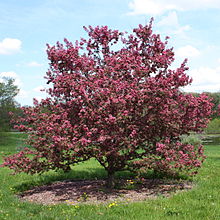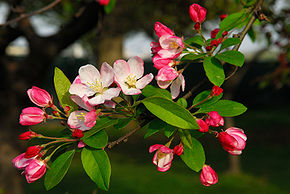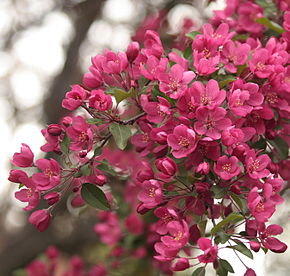- Malus
-
"Wild apple" redirects here. For the unrelated Australia tree, see Pouteria eerwah.
Malus Malus 'purple prince'[1] Scientific classification Kingdom: Plantae (unranked): Angiosperms (unranked): Eudicots (unranked): Rosids Order: Rosales Family: Rosaceae Subfamily: Amygdaloideae Tribe: Maleae Subtribe: Malinae Genus: Malus
Tourn. ex L.Species - See text
Malus (
 /ˈmeɪləs/[2] or /ˈmæləs/), the apples, are a genus of about 30–35 species of small deciduous trees or shrubs in the family Rosaceae. Other studies go as far as 55 species[3] including the domesticated Orchard Apple, or Table apple as it was formerly called (M. domestica, derived from M. sieversii, syn. M. pumila). The other species and subspecies are generally known as "wild apples", "crab apples", "crabapples" or "crabs".
/ˈmeɪləs/[2] or /ˈmæləs/), the apples, are a genus of about 30–35 species of small deciduous trees or shrubs in the family Rosaceae. Other studies go as far as 55 species[3] including the domesticated Orchard Apple, or Table apple as it was formerly called (M. domestica, derived from M. sieversii, syn. M. pumila). The other species and subspecies are generally known as "wild apples", "crab apples", "crabapples" or "crabs".The genus is native to the temperate zone of the Northern Hemisphere, in Europe, Asia and North America.
Apple trees are typically 4–12 m tall at maturity, with a dense, twiggy crown. The leaves are 3–10 cm long, alternate, simple, with a serrated margin. The flowers are borne in corymbs, and have five petals, which may be white, pink or red, and are perfect, with usually red stamens that produce copious pollen, and a half-inferior ovary; flowering occurs in the spring after 50–80 growing degree days (varying greatly according to subspecies and cultivar).
Apples require cross-pollination between individuals by insects (typically bees, which freely visit the flowers for both nectar and pollen); all are self-sterile, and (with the exception of a few specially developed cultivars) self-pollination is impossible, making pollinating insects essential. Malus species, including domestic apples, hybridize freely. Malus species are used as food plants by the larvae of a large number of Lepidoptera species; see list of Lepidoptera that feed on Malus.
The fruit is a globose pome, varying in size from 1–4 cm diameter in most of the wild species, to 6 cm in M. sylvestris sieversii, 8 cm in M. sylvestris domestica, and even larger in certain cultivated orchard apples; among the largest-fruited cultivars (all of which originate in North America) are 'Wolf River' and 'Stark Jumbo' . The centre of the fruit contains five carpels arranged star-like, each containing one to two (rarely three) seeds.
One species, Malus trilobata from southwest Asia, has three- to seven-lobed leaves (superficially resembling a maple leaf) and with several structural differences in the fruit; it is often treated in a genus of its own, as Eriolobus trilobatus.
Contents
Uses
For Malus sylvestris domestica, see Apple. The fruit of the other species is not an important crop in most areas, being extremely sour and (in some species) woody, and is rarely eaten raw for this reason. In some southeast Asian cultures they are valued as a sour condiment, sometimes eaten with salt and chili pepper, or shrimp paste.
Crabapples are an excellent source of pectin, and their juice can be made into a ruby-coloured preserve with a full, spicy flavor.[4] A small percentage of crabapples in cider makes a more interesting flavour.[citation needed] As Old English Wergulu, the crab apple is one of the nine plants invoked in the pagan Anglo-Saxon Nine Herbs Charm, recorded in the 10th century.
Crabapples are widely grown as ornamental trees, grown for their beautiful flowers or fruit, with numerous cultivars selected for these qualities and for resistance to disease.
Some crabapples are used as rootstocks for domestic apples to add beneficial characteristics.[5] For example, varieties of Baccata, also called Siberian crab, rootstock is used to give additional cold hardiness to the combined plant for orchards in cold northern areas.[6]
They are also used as pollinizers in apple orchards. Varieties of crabapple are selected to bloom contemporaneously with the apple variety in an orchard planting, and the crabs are planted every sixth or seventh tree, or limbs of a crab tree are grafted onto some of the apple trees. In emergencies, a bucket or drum bouquet of crabapple flowering branches are placed near the beehives as orchard pollenizers. See also Fruit tree pollination. Because of the plentiful blossoms and small fruit, crabapples are popular for use in bonsai culture; however, because the tiny trees still show the abundant, full-sized fruit of normal crabapples, it is important to thin out the fruit so that the trees do not exhaust themselves.
The Chestnut Crabapple is an exception in that its fruit is sweet tasting.[citation needed] A very hardy plant, the Chestnut Crabapple blooms in early to mid-May and is an excellent pollinator for other fruit apples. It produces a very large crabapple, up to 2" (5 cm) in diameter, that ripens in early September with a pleasant nut-like flavor and good texture for fresh eating. The fruit quality holds well on the tree, being quite spritely at first and becoming sweeter later on, with a medium storage life.
Apple wood gives off a pleasant scent when burned, and smoke from an apple wood fire gives an excellent flavour to smoked foods.[7] It is easier to cut when green; dry apple wood is exceedingly difficult to carve by hand [7] It is a good wood for cooking fires because it burns hot and slow, without producing much flame.[7]
Species
- Malus angustifolia — Southern crabapple
- Malus asiatica
- Malus baccata — Siberian crabapple
- Malus bracteata
- Malus brevipes
- Malus coronaria — Sweet crabapple
- Malus domestica — Orchard apple
- Malus florentina
- Malus floribunda — Japanese crabapple
- Malus formosana
- Malus fusca — Oregon crabapple or pacific crabapple
- Malus glabrata
- Malus glaucescens
- Malus halliana
- Malus honanensis
- Malus hopa — Flowering crabapple
- Malus hupehensis — Chinese crabapple
- Malus ioensis — Prairie crabapple
- Malus kansuensis
- Malus lancifolia
- Malus × micromalus — Midget crabapple
- Malus prattii
- Malus prunifolia
- Malus pumila
- Malus rockii
- Malus sargentii
- Malus sieboldii
- Malus sieversii — Asian wild apple or Almaty apple
- Malus sikkimensis
- Malus spectabilis
- Malus sublobata
- Malus sylvestris — European wild apple
- Malus toringoides
- Malus transitoria
- Malus trilobata
- Malus tschonoskii
- Malus yunnanensis
Cultivars
- Malus × moerlandsii Door. 'profusion' - Profusion crabapple
Photographs
Notes
- ^ Cirrus Digital Purple Prince Crabapple
- ^ Sunset Western Garden Book, 1995:606–607
- ^ Phipps, J.B. et aL. (1990). "A checklist of the subfamily Maloideae (Rosaceae)". Can. J. Bot. 68 (10): 2209. doi:10.1139/b90-288.
- ^ Rombauer, I.; Becker, M. R., & Becker, E. (2002) [2002]. All About Canning & Preserving (The Joy of Cooking series). New York: Scribner. pp. 72. ISBN 0-7432-1502-8.
- ^ Apple Tree Rootstocks Ecogardening Factsheet #21, Summer 1999
- ^ Alaska Department of Natural Resources
- ^ a b c Fraser, Anna. "Properties of different trees as firewood" 22 August 2005, 17 July 2008. Available at: [1]
References
- Germplasm Resources Information Network: Malus
- Flora of China: Malus
- Virginia Cooperative Extension - Disease resistant crabapples
- Ontario Ministry of Agriculture and Food - Crabapple pollenizers for apples
- The PRI disease resistant apple breeding program: a cooperative among Purdue University, Rutgers University, and the University of Illinois.
- Germplasm Resources Information Network: Diab
Categories:- Plants and pollinators
- Apples
Wikimedia Foundation. 2010.







